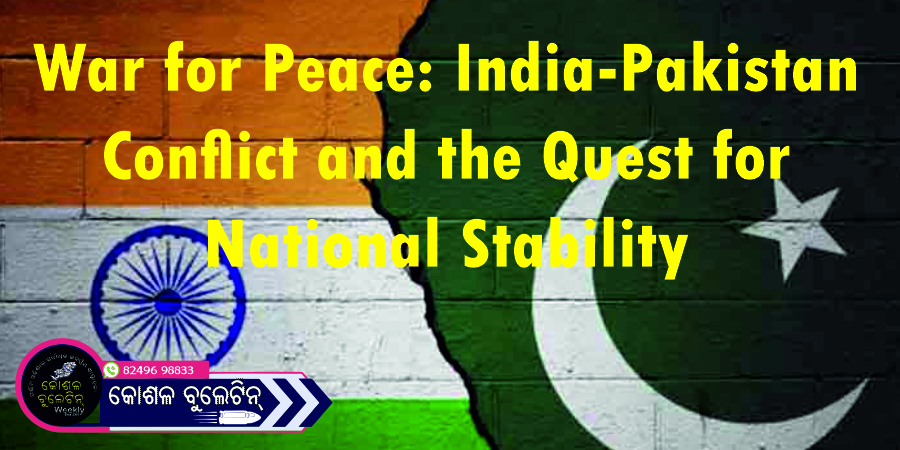The notion of waging war to achieve peace is a paradoxical concept, particularly in the context of the long-standing rivalry between India and Pakistan. Since their partition in 1947, the two nations have been locked in a bitter dispute, primarily over the region of Kashmir, leading to multiple wars, skirmishes, and ongoing cross-border tensions. The idea that India must decisively defeat Pakistan to establish lasting peace stems from frustration with Pakistan’s persistent support for terrorism and its unchanging stance on Kashmir. This article explores this perspective, critically examining its implications, historical context, and the broader quest for peace.
The India-Pakistan conflict traces its roots to the partition of British India in 1947, which created two independent nations: Hindu-majority India and Muslim-majority Pakistan. The princely state of Kashmir, with a Muslim-majority population but a Hindu ruler, became a flashpoint. Maharaja Hari Singh’s decision to accede to India sparked the first Indo-Pak war (1947-48), resulting in a UN-brokered ceasefire and the division of Kashmir into Indian-administered and Pakistan-administered regions.
Since then, the two nations have fought three major wars (1947, 1965, 1971) and the Kargil conflict (1999). The 1971 war led to the creation of Bangladesh from East Pakistan, a significant blow to Pakistan. Despite agreements like the Simla Accord (1972), which aimed to resolve disputes peacefully, tensions persist, fueled by Pakistan’s alleged support for militant groups like Lashkar-e-Taiba and Jaish-e-Mohammed, responsible for attacks such as the 2008 Mumbai attacks and the 2016 Uri attack.
Recent events underscore the ongoing volatility. On April 22, 2025, a terrorist attack in Pahalgam, Kashmir, blamed on Pakistan-based groups, killed civilians and escalated tensions. India launched “Operation Sindoor,” targeting Pakistani military bases, while Pakistan retaliated with “Bunyan Marsoos,” leading to missile and drone strikes. A ceasefire was announced on May 10, 2025, mediated by the U.S., but Pakistan violated it within hours, prompting India to accuse Pakistan of bad faith.
Proponents of the view that India must “completely defeat” Pakistan argue that Pakistan’s unchanging stance—supporting cross-border terrorism, violating ceasefires, and refusing to negotiate in good faith—leaves India with no choice but to take extreme measures. Pakistan’s military and intelligence agencies are accused of fostering militancy to destabilize India, particularly in Kashmir. Incidents like the 2019 Pulwama attack, which killed 40 Indian soldiers, and the recent Pahalgam attack reinforce this perception.
The argument posits that diplomatic efforts, such as the Simla Agreement or the 2003 ceasefire, have failed because Pakistan continues to sponsor terrorism. With both nations possessing nuclear arsenals, Pakistan’s provocations are seen as a dangerous gamble, risking catastrophic escalation. Some believe that a decisive military victory, potentially dismantling Pakistan’s ability to wage proxy wars, is the only way to secure lasting peace for India and the region.
While the idea of “completely defeating” Pakistan may appeal to those frustrated by decades of conflict, it is fraught with risks. Both nations are nuclear-armed, with India possessing over 180 warheads and Pakistan developing tactical nuclear weapons. A full-scale war could lead to unprecedented destruction, potentially killing millions and causing global environmental and economic fallout. Experts warn that even a limited nuclear exchange would be catastrophic, making such a strategy “stupid” though not impossible.
Conventional war also carries severe costs. The recent 2025 clashes, though brief, killed dozens of civilians and soldiers, displaced communities, and damaged infrastructure. Pakistan’s retaliatory strikes targeted Indian bases, while India destroyed Pakistani missile systems, showing the potential for rapid escalation. Economically, both nations would suffer, with India’s growing economy facing disruption and Pakistan, already unstable, risking collapse.
Moreover, “defeating” Pakistan could destabilize the region further. Pakistan’s 250 million population and its strategic position as a trade bridge to China and Central Asia mean its collapse could create a power vacuum, fueling extremism and drawing in global powers like China, a close ally of Pakistan. India’s own social fabric, particularly in border regions like Jammu and Kashmir, would face immense strain, as seen in the recent blackouts and fear among residents.
The recurring failure of ceasefires—Pakistan violated the May 10, 2025, agreement within three hours—highlights the need for alternative approaches. Diplomacy, though challenging, has shown results in the past. The Indus Waters Treaty and the Simla Agreement, despite current strains, provided frameworks for cooperation. International mediation, as seen in the U.S.-led ceasefire talks in 2025, can de-escalate tensions, though lasting peace requires Pakistan to curb terrorism.
Non-military strategies are equally vital. Strengthening India’s internal security, investing in counter-terrorism, and addressing Kashmiri grievances through dialogue can reduce Pakistan’s leverage. Economic and cultural engagement, such as resuming trade or people-to-people contact, could foster goodwill, though this is currently unlikely given Pakistan’s stance. India’s focus on global diplomacy, as seen in its firm anti-terrorism stance, can pressure Pakistan internationally.
The idea of India “completely defeating” Pakistan to achieve peace is driven by legitimate frustration with Pakistan’s unrelenting hostility. However, the risks of nuclear war, regional instability, and humanitarian catastrophe make this approach untenable. India’s strength lies in its resilience, diplomatic leverage, and commitment to peace through development and unity. Rather than annihilation, a combination of robust defense, international pressure on Pakistan, and internal reforms offers a more viable path to lasting peace




